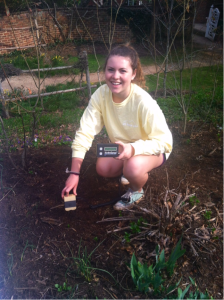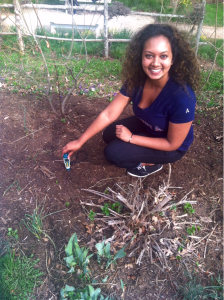On an overcast, stickily-humid April day, the Gardens taskforce of the Life in Soils team traipsed across the Lawn to the even-numbered Gardens lying between the Pavilions and East Range. There, we settled on Pavilion Garden II, a tiered landscape featuring a diverse spread of edible plants, including a large pecan tree, blueberry bushes, grape vines, four varieties of heirloom plums and crabapple trees. The garden is also home to daylilies and a magnolia tree. This garden would be the site for our data collection of soil moisture and pH measurements in order to test the soil quality and therefore extrapolate on the health of the Gardens. We then moseyed around, surveying the soils in each patch of landscaped shrubbery and plants. We came to choose three sites within the garden with which to average our data on soil moisture and pH. The first (1) was a mostly bare patch of soil, with some onions and what looked to be tulips poking out of the ground nearby. The second (2) place was a spot beneath a number of plants nestled around it. The third (3) was nearer to the Rotunda side of the garden, and therefore closer to the construction work that is still underway, right next to a large tree.
Area (1)
Area (2)
Area (3)
Why do soil moisture and the pH level of soil matter?
First, let’s talk about what each measurement means. Soil moisture content tells you how much water is in the soil, usually as a percentage, representing what percentage of total ‘volume’ of soil is moisture. The amount of water that’s in the soil is of fundamental importance to many hydrological, biological and biogeochemical processes. It determines how much water is available for surrounding plants to take up and is a key variable in controlling the exchange of water and heat energy between the land surface and the atmosphere through evaporation and plant transpiration. Soil moisture, then, plays an important role in development of weather patterns and the production of precipitation. It also directly affects topsoil and nutrient runoff into nearby streams and rivers, resulting in pollution and ecosystem health implications. Soil moisture information can be used for reservoir management, early warning of droughts, irrigation scheduling, and crop yield forecasting.
Soil pH, on the other hand, is an indication of the acidity or alkalinity of soil and is defined as the negative logarithm of the hydrogen ion concentration. The pH scale ranges from 0 to 14, with 7 as neutral. From pH 7 to 0 the soil is increasingly more acidic and from pH 7 to 14 the soil is increasingly more alkaline or basic. Soil pH has a significant effect on the solubility of essential minerals and nutrients that plants need to obtain from soil. Before plants can use a nutrient it must be dissolved in the soil solution. Most minerals and nutrients are more soluble or available in acidic soils than in neutral or slightly alkaline soils. However, a soil that’s strongly acidic can also be toxic to the growth of certain plants. A pH range of approximately 5.5 to 7.0 promotes the most readily available plant nutrients for most plants. Additionally, soil pH can influence the activity of beneficial microorganisms, affecting plant growth. Bacteria that decompose organic matter are hindered in strongly acidic soils, resulting in a lack of available nutrients, particularly nitrogen, for plants to use to grow effectively.
Testing the soil moisture content
Testing the pH level
The data we collected is as follows:
Soil Moisture
(1) VMC (volume moisture content) 55%
(2) VMC 58%
(3) VMC 34%
* Average soil moisture content: 49% *
pH Level
(1) 6.84
(2) 6.76
(3) 4.47
* Average pH: 6.02 *
Conclusions drawn from the data:
The soil moisture content average at 49% indicates that the soil in the gardens is most likely at an optimal water content level in order for plants to transpire maintain normal plant growth. In area (3), the soil was composed of more clay and was located right next to a large tree, which could account for the less soil moisture content recorded there.
The average 6.02 pH level we recorded is classified as a moderate acid, which is in the range that is optimal for most plant growth, indicating that the nutrients and minerals in the soil are able to be dissolved in the soil solution and taken up by plants. At this level, it is most likely that the soil is rich with the nutrients plants need to grow and thrive. It is interesting to note however, that area (3) had a noticeably lower pH than the other two locations. The higher acidity found here is most likely due to its proximity to the construction that was occurring right on the other side of the undulating brick wall.
Final thoughts + musings:
So why did we, a group of busy college students with meetings to attend and essays to write, take the time out of our day to go out into the gardens and measure some components of soil? Besides the fact that we were assigned this project, we have truly come to realize how important it is to measure soil health because of the impacts and implications soil has on the ecosystems and nature it supports. Soil is one of the fundamental components of natural systems and fluctuations in the nutrients, minerals and water that composes this vital substance can affect biological functioning, environmental quality, and plant and animal health. Understanding the interactions between soil properties and management will ensure the adoption of appropriate practices to improve and maintain the health of our soils. And ultimately, the health of our soils determines the health of us as individuals, contributing to our happiness and overall wellness. Every time I step outside, I look down to the soil at my feet and feel gratitude and awe for the often-overlooked substance that provides the wondrous opportunity for growth and life.
References:
http://wwwghcc.msfc.nasa.gov/landprocess/lp_home.html
http://www.esf.edu/PUBPROG/brochure/soilph/soilph.htm
Post by Allie Arnold




